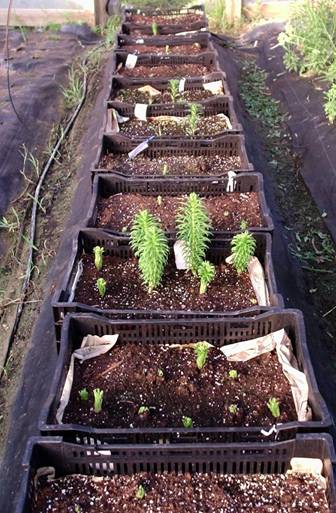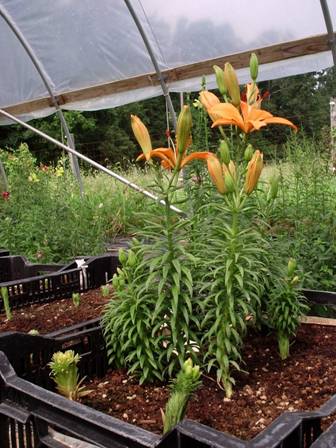Growing Asiatic Lilies in Crates in a Hoop House-2004 Report
go.ncsu.edu/readext?441691
en Español / em Português
El inglés es el idioma de control de esta página. En la medida en que haya algún conflicto entre la traducción al inglés y la traducción, el inglés prevalece.
Al hacer clic en el enlace de traducción se activa un servicio de traducción gratuito para convertir la página al español. Al igual que con cualquier traducción por Internet, la conversión no es sensible al contexto y puede que no traduzca el texto en su significado original. NC State Extension no garantiza la exactitud del texto traducido. Por favor, tenga en cuenta que algunas aplicaciones y/o servicios pueden no funcionar como se espera cuando se traducen.
Português
Inglês é o idioma de controle desta página. Na medida que haja algum conflito entre o texto original em Inglês e a tradução, o Inglês prevalece.
Ao clicar no link de tradução, um serviço gratuito de tradução será ativado para converter a página para o Português. Como em qualquer tradução pela internet, a conversão não é sensivel ao contexto e pode não ocorrer a tradução para o significado orginal. O serviço de Extensão da Carolina do Norte (NC State Extension) não garante a exatidão do texto traduzido. Por favor, observe que algumas funções ou serviços podem não funcionar como esperado após a tradução.
English
English is the controlling language of this page. To the extent there is any conflict between the English text and the translation, English controls.
Clicking on the translation link activates a free translation service to convert the page to Spanish. As with any Internet translation, the conversion is not context-sensitive and may not translate the text to its original meaning. NC State Extension does not guarantee the accuracy of the translated text. Please note that some applications and/or services may not function as expected when translated.
Collapse ▲This is a 2004 report from a NC Specialty Crops Program Project. It is posted for historical reference purposes.
PROJECT LEADER(S): Willie Wilson & Patricia Raible, Co-Owner Morning Glory Farm
LOCATION: Morning Glory Farm
MGF Flowers, LLC
6205 Kate Road
Monroe, NC 28110-9402
Union County
IMPACT
A field day was held on September 14, 2004 at Morning Glory Farm. Twenty-five local producers, potential specialty crops growers and Master Gardeners participated in a Field Day at Morning Glory Farm on September 14, 2004 from 9:00 to 12:00 Noon. Participants had the opportunity to look at the on-farm trail, ask questions, and visit other sites of interest at the farm.
INTRODUCTION
Test Trial: Our research was designed to determine if Asiatic Lilies would grow during the summer months in North Carolina under partially controlled conditions in a hoop house. We tested five varieties of bulbs over a 14-week period.
METHODS
We were assured by Ednie Bulb Company that the lilies would grow in heat and humidity under the following conditions:
- The bulbs need to be cool until they emerge. To accomplish this the bulbs were placed in a cooler at 45 degrees until planted. Both the hoop house and the crates were covered with 50 percent shade cloth.
- Lilies are sensitive to fluoride which comes in chemical phosphate fertilizer. You should also not use a mix with too much perlite. We used ½ peat moss and ½ Farfard 2 mix (low perlite). Because lilies also need calcium we added milk powder.
- Too much moisture causes Botrytis. Bulbs were watered by overhead mist, but checked daily. A 24 inch greenhouse fan provided air circulation. Sides and back of the hoophouse were open.
CONCLUSION
We found the crop a disappointment for the 2004 summer season. Contrary to the information provided from the company, we believe the 93 degree plus heat in early June just after the bulbs were planted was the largest factor in the slow emergence and the stunted growth of the bulbs. Also, we believe we should have dripped the bulbs instead of overhead watering to ensure more thorough, but less daily watering. Since we believe lilies may be better as a spring crop, we will try the bulbs again in crates, beginning in February and throughout the spring, but no later than May 15th.
TABLES & PHOTOS
|
Calendar
|
|
| June 1 | Received crates and bulbs put them in our cooler, at about 45 degrees |
| June 5 |
Prepared crates and planted 1. lined crates with newspaper 2. soil was ½ peat moss, ½ Farfard 2 mix (no bark) lime, powdered milk, seabird guano 1# (10-10-2.5) 3. 2 inches soil on bottom, bulbs, covered up to handles 4. placed in hoop house (that was covered with 50% shade cloth), crates were also covered with 50 percent shade cloth until the lilies emerged. |
| June 10 | Temperature rises to mid-90’s, watered with sprinklers 4 times a day for 15 minutes. Checked daily to make sure they were not drying out. |
| June 15 | First bulbs, Van Holden, emerged on time (We were told they would emerge about two weeks earlier during warm weather |
| June 20 | Took shade cloth off crates since first bulbs were at the top, still only a few emerging. |
|
July 5 |
Concerned with slow emergence, not growing very fast. Fertilized with composed chicken manure (Black Hen/2-3-2) and watered with Omega (6-6-6), a compost tea. |
| July 18 |
All bulbs should have emerged, but only about 60 percent had emerged by this date.
|
| July 26 | First two buds, but plants only about 18-20 inches tall. Remainder of the bulbs continue to bud off and on through July and August, but total budding only about 30 percent of those planted and all but a few, very short. |
Posted by Jeanine Davis, NC Alternative Crops & Organics Program, Department of Horticultural Science, NC State University. Reviewed 7/15/2022.




